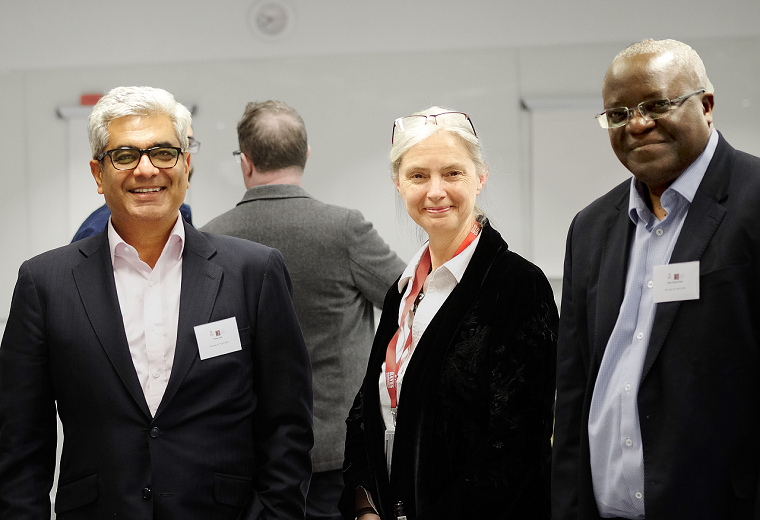How collaborative working across the globe is increasing innovation and creativity
Bayes Business School centres showcase breadth of innovative and creative collaborations across the globe to celebrate World Creativity and Innovation Week.
The Centre for Creativity in Professional Practice (C2P2) and The National Centre for Creativity enabled by AI (CebAI), celebrated the range and diversity of collaborations around the world as part of the United Nations' World Creativity and Innovation Week.
The event, hosted by Bayes Business School, welcomed a global audience including an international speaker panel to showcase examples of projects from the Innovation for African Universities (IAU) programme. City, with colleagues from the University of Nairobi and ChangeSchool Ltd, is a partner in the IAU programme’s Centre of Excellence which is being funded by the British Council to support the work of 24 projects across Ghana, Kenya, Nigeria, South Africa and the UK.
The hybrid panel session discussed the value of collaboration for innovation. It was moderated by Viren Lall, Managing Director at ChangeSchool, with the speakers Professor Mary Kinoti of the University of Nairobi; Dr Kwabena Obeng Duedu, senior lecturer at the University of Health and Allied Sciences in Ghana; Judy Kepher-Gona, Director and Lead Consultant Sustainable Travel and Tourism Agenda in Kenya; Rebecca Leatherland, Research Associate at Aston University; Professor Sam Kamuriwo, Professor of Strategy and Innovation at Bayes and Dr Sara Jones, Director of the Centre for Creativity in Professional Practice.
Professor Kamuriwo praised the impact of the IAU programme, adding that he was proud of its progress.
“The aim is to get students who are more employable, to create better quality start-ups and reduce unemployment. In the 24 projects we have the universities are reaching communities outside of mainstream entrepreneurial education. Universities are becoming institutions that can offer the entrepreneurial support that budding entrepreneurs need to succeed.”
Rebecca Leatherland described the Inclusive Innovation project, one of the 24 projects supported by the IAU programme, which is a partnership involving the Central University of Technology in Bloemfontein, Disabled People South Africa, and the Southern Africa Federation of the Disabled (SAFOD). The project focuses on the development of sustainable, inclusive enterprises for people with disabilities.
“We want to bridge the gap between rich and poor,” she said. “We are working with manufacturers in South Africa to create two sustainable and specialised wheelchairs – both have been created by disabled entrepreneurs and both provide freedom and support mental health as well as physical health.”

Professor Mary Kinoti described the IAU programme partnership between Bayes, ChangeSchool and the University of Nairobi as “extremely important”. She added: “There is a lot of contextual wisdom and sharing that has resulted in innovations that are addressing the challenge of youth unemployment in sub-Saharan Africa.”
Dr Duedu, who is working in another IAU project with partners in the UK and the University of Cape Coast, highlighted a gap between academic knowledge and translation into practice in the biosciences. “We are working to create knowledge exchange programmes in Africa so we can be self-reliant in bio-medical innovations. Assembling entrepreneurs in biosciences has resulted in additional sharing of stories and is encouraging collaboration instead of competition.”
Ms Kepher-Gona shared her experience of working on an IAU project involving 5 different partner organisations aimed at accelerating youth entrepreneurship in tourism and climate innovation. “Harmonising the different traditions between organisations was not always easy, but all our institutions have learned a lot through this process.”
In addition to the panel, 15 Collaborative partnerships were on display at the exhibition including:
- Creative writer, Stephanie Terwindt, and Illustrator, Anita Salamanca, presented the makings behind their upcoming Webcomic, The Las Primas – a collaboration crossing many time zones with one artist being UK-based and the other in Australia
- Dressed in traditional Ghanian attire, Dr Denis Hyams-Ssekasi, exhibited ‘Graduate employability in the HE framework: The Ghanaian perspective’
- Innovation, Entrepreneurship and Higher Education which was highlighted by Dr Paul Igwe
The occasion marked the launch of the interactive C2P2 World Map of Collaboration, powered by CebAI, hosting information about all these collaborations. The map also shows many other innovators, partners, graduates and associates of C2P2 and CebAI, who are conducting collaborative projects around the world. Further information about ongoing collaborations is due to be added to the map throughout the year ahead.
“It was wonderful to see such a range of collaborative projects coming together as part of this event,” said Dr Jones, Course Director on the MSc in Innovation, Creativity and Leadership. “It felt like a real celebration of the power and potential of effective collaboration.”
Ends
